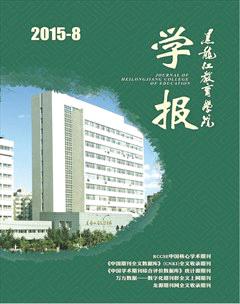英文学术论文中转述语中转述信号研究
黄晶伟,刘 冰
(1.黑龙江财经学院外语系,哈尔滨 150025;2.黑龙江外国语学院英语系,哈尔滨 150025)
引言
长期以来转述一直是英语语言中被人们广泛关注的一种常见语言现象。传统语法中有关于引语的研究,主要分为直接引语和间接引语。二十世纪八十年代夸克等[1]1020—1033的相关论述堪称传统语法在这一领域研究的典范。他们认为转述最直接的方式是由转述分句(Reporting Clause)和被转述分句(Reported Clause)构成。转述分句涉及到讲话者和以语言或文字进行交际的行为等,因而转述分句引导交际内容的转述;而被转述分句则可以取直接引语或间接引语的形式。该描述清晰明确,但视野过于狭窄,无法解释一些显然在转述他人的话语,却无法归结于传统语法中任何一种转述形式,不适合应用于实际语篇分析,而本文所要探讨的转述涵盖范围要更为广泛。
一、转述语的定义
直接引语和间接引语是人们在语法书和教科书中司空见惯的概念,很多人甚至认为根本无需对转述进行定义。然而在真实的文本中,却有很多显然在转述他人的语言,但却不能被归结为上述范畴的语言现象。如:
(1)An agent is,according to Aristotle,a substance operating on another substance,the patient,which is passive with respect to the process of operation and sometimes resists the agent's influence.
例(1)中,作者通过according to这一转述信号转述了亚里士多德的观点,但是该部分却不是一个转述分句,因此用传统意义上的转述无法解释这句话。为了解决传统语法在这方面的不足,本文借鉴巴赫金[2]281的“多声性”概念,把转述语定义为文本中有转述信号指示的各种声音。也就是说,转述语包括说话人或作者用转述信号表明有任何其他声音进入文本之中的语言单位[3]501—530。一个表达转述的句子由转述信号(reporting signal)和转述信息(message)两个部分组成[4]1。
二、转述信号
作为转述句的重要组成部分,转述信号表明说话人或作者在引述他人的话,而非直接表达自己的观点或看法。传统转述研究的转述信号一般为转述动词,但本文中还包括转述名词、转述形容词和转述状语[4]。以下以2013年到2015年间英语国家权威的学术期刊The Cognitive Science,Journal of Sociolinguistics,International Journal of Applied Linguistics,World Englishes,The Modern Language Journal等中的学术论文为语料,对各种转述信号加以探讨。
1.转述动词
在直接引用结构和传统的间接转述结构中,转述信号都由转述小句承载,通常为转述动词。如:
(2)‘We all know the warning bell she's talking about,right?',asksLiberman rhetorically,‘That one over there,always in the back of our shared experience'(2010:n.p.).
(3)Studiespoint outthat stay abroad allows for greater benefits than CLIL and that CLIL yields better results than formal instruction among children and teenagers(Pérez-Vidal 2011).
例(2)是直接引用结构,转述小句中的动词asks为转述信号;在间接转述结构例(3)中,转述小句中的动词point out为转述信号。
选择不同的转述动词可表明说话人或作者对转述信息持有不同的态度,如在例(2)中作者在转述他人所说的话语,没有附带任何作者的个人倾向,作者在该句中保持中立的立场。常见的表达中性转述的动词还有say,write,describe,discuss,mention,comment,add等。当然说话人或作者也可以通过转述动词的选择来表达自己对所转述的信息的态度,如:
(4)Dawkins has himself beencriticizedfor personifying the gene(e.g.Sullivan 1995).
(5)Nusrataffirmswhat is gained when researching multilingually,noting that her research participants produced reflections of differing types in think-aloud protocols,depending on the language they used.
例(4)中的转述动词criticized明显表达强烈反对的意味,说话人或作者常可用下列动词表达怀疑或反对:challenge,accuse,distort,claim,allege,purport,exaggerate,overlook,simplify,misinterpret,misinform,misquote等。而例(5)中的转述动词affirms带有赞同之意,类似表达支持或赞同意味的动词还有:acknowledge,admit,confess,reveal,discover,illustrate,demonstrate,explain,prove,find,show,make clear,point out等。
2.转述状语
在上述各例中,转述符号都是由转述小句承载,但转述信号也可以由转述状语来承载。转述状语有:副词,如apparently,reportedly,allegedly,supposedly等;介词短语,如according to,in one's words,in one's opinion,in one's view 等;非限定小句,如to quote等;从属限定小句,如as far as...is concerned,as sb put it,as sb said/pointed out/argued/admitted等。如:
(6)In this section,we first identify the kinds of behaviour and/or actions that the creatures arereportedlyunder an obligation to perform.
(7)The type of encoding is linked,in Talmy's(1985,2000)view,to information salience in sentence processing:The encoding of motion components in the main verb places the meaning in the background(e.g.,I drove to New York),while other types of encoding place the same meaning in the foreground(e.g.,I went to New York by car).
(8)To quote Davis(2013:377),they‘created a space for new ways of thinking about English as a world language'especially for understanding how English is nativized to the uses and needs of speakers in contexts across the globe as well as for considering the social and cultural parameters relevant to the settings in which participants find themselves.(Valentine,2015)
(9)Undoubtedly,these components can be expressed in other languages through a variety of means;yet,as argued by Lucy(1992,1996),what matters most in the study of language effects on cognition is not what can be expressed but what must be expressed.
3.转述名词
除了上述谈及的转述动词和转述状语外,一些名词也可以充当转述信号。转述名词可以用于直接引文中,转述信息由引文构成;也可用于间接转述结构。常用的转述名词有assumption,acknowledgement,argument,claim,concern,criticism,explanation,implication,objection,statement,suggestion等。转述信息一般在转述名词之后,由that小句、wh-小句、带to的不定式小句构成,有时转述名词与转述信息间也可用冒号隔开,如:
(10)In the case of salience,Talmy(1985,2000)and Slobin(2006)actually makeincompatible assumptionsabout the effects of encoding:The former views encoding in the main verbs as backgrounding of motion components and the latter as heightening their salience.
(11)In the past decade,several linguists have raisedconcernsabout Talmy's(1985,2000)typology:Some identified S-languages with low manner verb usage and V-languages with low path usage,such as Romansh,while others identified languages,such as Arrernte or Basque,that do not easily fit within S-and V-categories(e.g.,Levinson & Wilkins,2006;Strmqvist& Verhoeven,2004).
4.转述形容词
许多形容词后面可接that小句表达转述,小句部分是转述信息,如下例中的转述形容词insistent。be加上转述形容词后,功能类似于转述动词,因此例(12)中的keenly insistent that...可用 keenly insisting that...来代替。
(12)This interpretation is in marked contrast to claims on the part of popular press accounts keenlyinsistentthat such signs embed a level of absurdity(Lansky 2007;Radtke 2007).(Pandey,2015)
结语
本文重新梳理了转述的定义,指出传统关于转述定义的不足,扩展了转述的定义以及转述信号涵盖的范围,以期能够更好地解释真实文本中各种不同的转述现象,便于发现英文学术论文作者如何通过转述或支持并加强自己的观点,或反驳他人观点而为发展自己的新观点做出铺垫,从而使自己的学术论文论证更加有力。
[1]Quirk,R.,S.Greenbaum,G.Leech and J.Svartvik.A Comprehensive Grammar of the English Language[M].London:Longman,1985.
[2]Bakhtin,M.The Dialogic Imagination[M].Austin:University of Texas Press,1981.
[3]Thompson,G.Voices in the Text:Discourse Perspectives on Language Reports[J].Applied Linguistics,1996,(17).
[4]Thompson,G.Reporting[M].Beijing:Foreign Languages Publishing House,2000.
(责任编辑:刘东旭)

